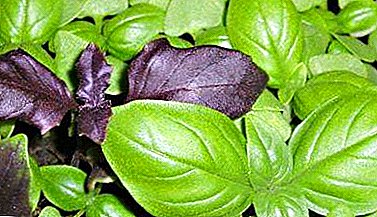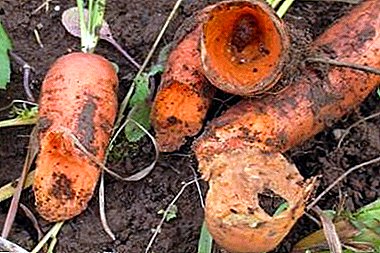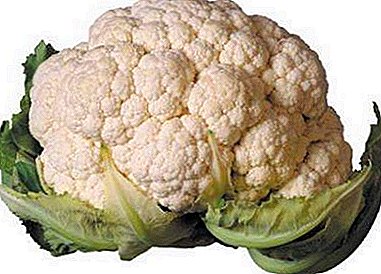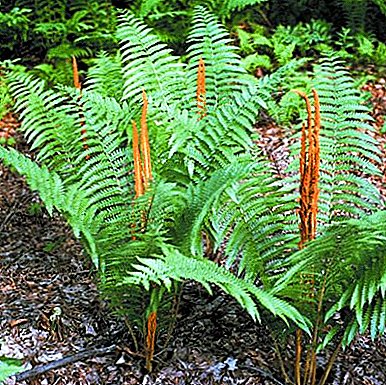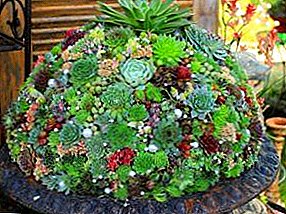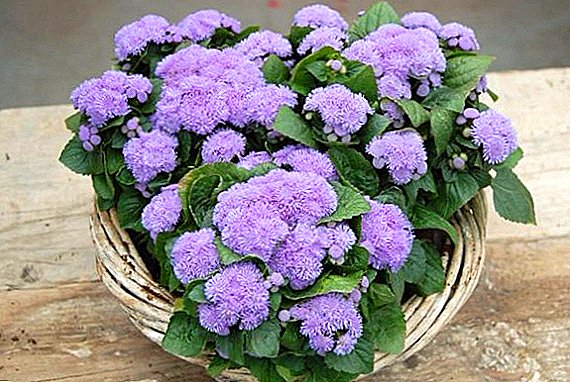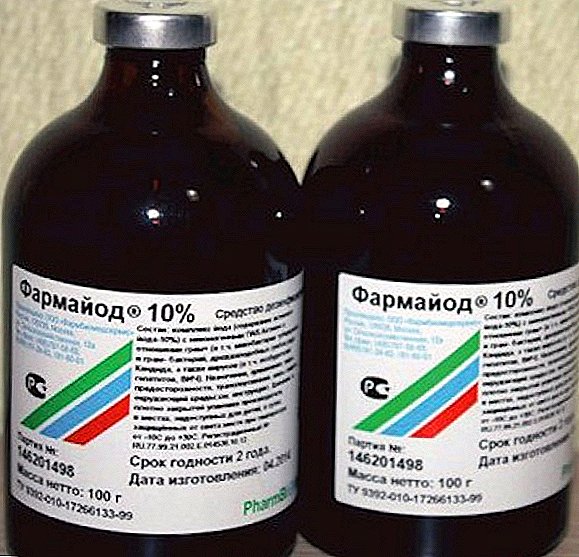 For agricultural needs created a lot of drugs that fight pathogens that cause diseases of plants and animals. Many products poison the soil or harm the finished product. In contrast, the farmodion does not harm plants and the environment. Today we will talk about the drug Pharmamod and its use in gardening for disinfection of premises and as a veterinary drug.
For agricultural needs created a lot of drugs that fight pathogens that cause diseases of plants and animals. Many products poison the soil or harm the finished product. In contrast, the farmodion does not harm plants and the environment. Today we will talk about the drug Pharmamod and its use in gardening for disinfection of premises and as a veterinary drug.
Description, composition and release form
 Farmod has in its composition active iodine, on the basis of which the disinfectant functions of the drug are built. The percentage of the active substance is 10%, the rest is a non-ionic surfactant.
Farmod has in its composition active iodine, on the basis of which the disinfectant functions of the drug are built. The percentage of the active substance is 10%, the rest is a non-ionic surfactant.
Pharmaiod - disinfectant antiseptic preparation extensive spectrum of action.
The drug is produced in glass or polymer containers of this volume: 50, 100, 500, 1000 and 5000 cubic meters. cm.
Iron sulfate and Brovadez-plus drug also have disinfectant properties.
What is needed and where to apply: pharmacological properties
Now let's talk about how iodine, which is part of the drug and is its basis, works.
After treating plants with famaiod, pathogenic organisms that are in the radius of damage do not just get burned. The active substance, penetrating into the cells of parasites, inhibits enzyme systems and breaks the habitual cellular metabolism.
When iodine interacts with water in the cells, oxygen is released and strong oxidation occurs. As a result, the microorganism dies due to serious changes at the cellular level.
Pharmaiodine is used to treat plants from non-spore-forming fungi, microorganisms and bacteria. Also, the drug is treated with greenhouse and working tools to conduct high-quality disinfection.
How to apply: dose and method of application
Consider pharmaiodine dosage for different crops and talk about other uses.
Did you know? Lethal iodine dose for a person - 3 g at a time.
Let's start with the fact that the drug is most often used not for plants. Acceptable price and good disinfectant qualities led to its use in animal husbandry. With the help of Farmod carry out the treatment of pigsties, poultry houses, disinfect warehouses, carry out prevention of viral diseases.
Disinfection of soil: add 10 ml of solution to 1 l of water. We water from a watering can. On 1 square. m. pour in about 2 liters of solution.
Important! In case of severe infection, the concentration can be increased threefold.
Processing farmoydom greenhouses and greenhouses. For 10 liters of water, 100 ml of Pharmaiode are taken and all parts of the structure are rubbed. Consumption per 1 square. m. - 100-300 ml of solution.
Disinfection of warehouse. Before storing agricultural products, the room is disinfected with pharmamod solution (100 ml per 100 l of water).
Important! During disinfection the temperature in the room should not be below 0 ° C.
Treatment of premises that contain livestock. Conduct a wet cleaning of the room with 1% solution of farmojoda. Consumption - 200-300 ml per square meter.
Treatment of wounds in animals. Used for cauterization and disinfection after childbirth or castration. Process 5% solution of the drug.
Let us return to the agricultural value of pharmaiodus and talk about the instructions for use on cucumbers.
Let's start with the soaking of seeds. Planting material for half an hour is immersed in a solution of farmod (1 ml per 200 ml of water). After that, the seeds must be washed under running water.

Processing at the stage of 2-4 sheets. We carry out a one-time spraying of the seedlings with farmod solution (3 ml per 10 l of water).
Further processing is carried out under the root (10 ml per 10 liters of water). Under each plant pours up to 0.5 liters of solution.
Now about the use of farmaioda on tomatoes.
In order to prevent and treat many diseases, other biopreparations are also used: Gaupsin, Shining-1, Shining-2, Trichoderma veride, Immunocytophyte, PhytoDoctor, Trichodermin.
Seed treatment is carried out by analogy with cucumbers with preservation of all dosages.
If a tomato has infected the disease at the stage of 5-7 true leaves, the culture can be sprayed with a solution of pharmamodus (1 ml per 2 liters of water) and make immunostimulating preparations.
Processing at the stage of flowering, budding and fruiting is carried out with a solution with the same concentration by analogy with the treatment of "adult" cucumbers (10 ml / 10 l, up to 500 per 1 bush).
Farmod used for spraying potatoes in the phase of flowering and budding. Spray the bushes 2-3 times with an interval of 10 days (4 ml per 10 liters of water). In addition to spraying, we introduce immunostimulants under the root.
Contraindications and side effects
A drug has no side effects for both animals and plants. It is worth noting that iodine kills not only pathogens, but also beneficial microorganisms, so if you use pharma-iodine for the treatment of open ground, use a 1% solution.
Did you know? In forensic science, iodine vapor is used to detect fingerprints on paper surfaces.
Shelf life and storage conditions
Pharmamodio's shelf life is 5 years under the following conditions: temperature is from -5 to + 30˚С, humidity does not matter.

The drug Farmod has a lot of positive reviews, because it destroys a large range of harmful organisms and does not contaminate the treated areas with toxic chemicals. That is why it is popular not only among gardeners and gardeners, but also among veterinarians.


